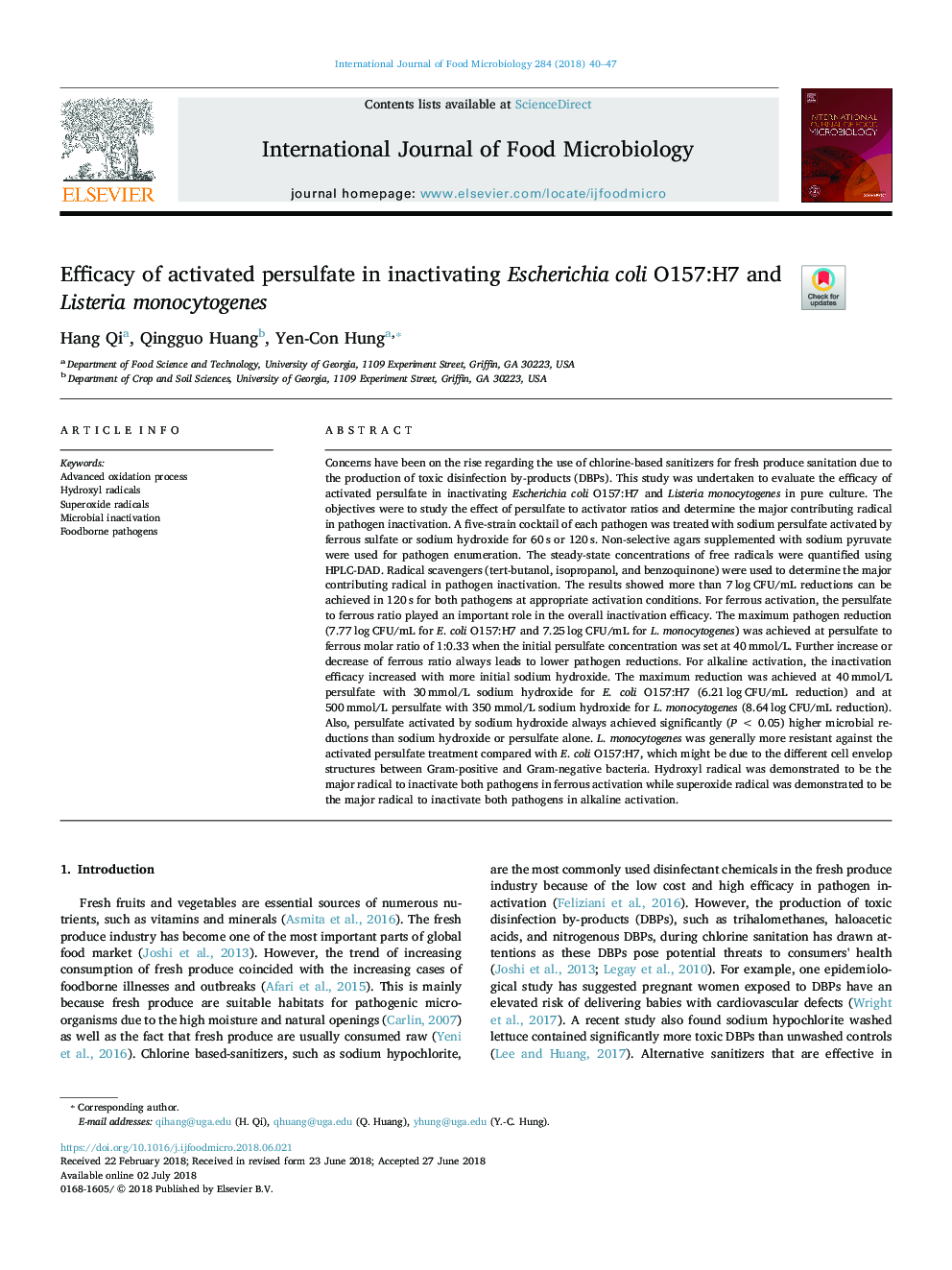| کد مقاله | کد نشریه | سال انتشار | مقاله انگلیسی | نسخه تمام متن |
|---|---|---|---|---|
| 8844088 | 1616499 | 2018 | 8 صفحه PDF | دانلود رایگان |
عنوان انگلیسی مقاله ISI
Efficacy of activated persulfate in inactivating Escherichia coli O157:H7 and Listeria monocytogenes
دانلود مقاله + سفارش ترجمه
دانلود مقاله ISI انگلیسی
رایگان برای ایرانیان
کلمات کلیدی
موضوعات مرتبط
علوم زیستی و بیوفناوری
علوم کشاورزی و بیولوژیک
دانش تغذیه
پیش نمایش صفحه اول مقاله

چکیده انگلیسی
Concerns have been on the rise regarding the use of chlorine-based sanitizers for fresh produce sanitation due to the production of toxic disinfection by-products (DBPs). This study was undertaken to evaluate the efficacy of activated persulfate in inactivating Escherichia coli O157:H7 and Listeria monocytogenes in pure culture. The objectives were to study the effect of persulfate to activator ratios and determine the major contributing radical in pathogen inactivation. A five-strain cocktail of each pathogen was treated with sodium persulfate activated by ferrous sulfate or sodium hydroxide for 60â¯s or 120â¯s. Non-selective agars supplemented with sodium pyruvate were used for pathogen enumeration. The steady-state concentrations of free radicals were quantified using HPLC-DAD. Radical scavengers (tert-butanol, isopropanol, and benzoquinone) were used to determine the major contributing radical in pathogen inactivation. The results showed more than 7â¯logâ¯CFU/mL reductions can be achieved in 120â¯s for both pathogens at appropriate activation conditions. For ferrous activation, the persulfate to ferrous ratio played an important role in the overall inactivation efficacy. The maximum pathogen reduction (7.77â¯logâ¯CFU/mL for E. coli O157:H7 and 7.25â¯logâ¯CFU/mL for L. monocytogenes) was achieved at persulfate to ferrous molar ratio of 1:0.33 when the initial persulfate concentration was set at 40â¯mmol/L. Further increase or decrease of ferrous ratio always leads to lower pathogen reductions. For alkaline activation, the inactivation efficacy increased with more initial sodium hydroxide. The maximum reduction was achieved at 40â¯mmol/L persulfate with 30â¯mmol/L sodium hydroxide for E. coli O157:H7 (6.21â¯logâ¯CFU/mL reduction) and at 500â¯mmol/L persulfate with 350â¯mmol/L sodium hydroxide for L. monocytogenes (8.64â¯logâ¯CFU/mL reduction). Also, persulfate activated by sodium hydroxide always achieved significantly (Pâ¯<â¯0.05) higher microbial reductions than sodium hydroxide or persulfate alone. L. monocytogenes was generally more resistant against the activated persulfate treatment compared with E. coli O157:H7, which might be due to the different cell envelop structures between Gram-positive and Gram-negative bacteria. Hydroxyl radical was demonstrated to be the major radical to inactivate both pathogens in ferrous activation while superoxide radical was demonstrated to be the major radical to inactivate both pathogens in alkaline activation.
ناشر
Database: Elsevier - ScienceDirect (ساینس دایرکت)
Journal: International Journal of Food Microbiology - Volume 284, 2 November 2018, Pages 40-47
Journal: International Journal of Food Microbiology - Volume 284, 2 November 2018, Pages 40-47
نویسندگان
Hang Qi, Qingguo Huang, Yen-Con Hung,